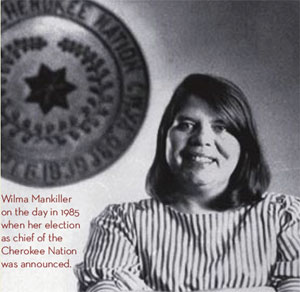国務省出版物
女性実力者の系譜-政府における女性の役割 「ウィルマ・パール・マンキラー」

チェロキー・ネーション首長への就任が公表された日のウィルマ・マンキラー(1985年)
アメリカ原住民国家初の女性首長
1945年11月18日生まれ、2010年4月6日死去
ウィルマ・マンキラーは、チェロキー・ネーションで初めての女性首長に選出される前に、「チェロキーの少女たちは、自分が大きくなったら首長になるなどとは考えたこともなかったでしょう」と語った。
米国有数の大規模な部族の首長となり、部族の人々のために活発な共同体構築プログラムを確立したウィルマ・マンキラーは、オクラホマ州タレクアで生まれた。マンキラー一族によると、その名字はチェロキーの軍隊における位を表すものであるという。マンキラーの少女時代に、米国政府のインディアン転住政策によって、一家はサンフランシスコに強制的に移住させられた。そこで彼女は1960年代末のアメリカ原住民活動家の運動に参加した。これは、60年代の第3世界における国家主義の発展、そして米国内の公民権運動からインスピレーションを得た運動であった。若い男性のグループが、アメリカ原住民が受けた不当な扱いに抗議して18カ月間にわたってアルカトラズ刑務所を占拠した際、マンキラーは彼らを支援し弁護するための資金を集めた。こうした体験を通じて、彼女はアメリカ原住民の社会的・経済的な問題、そして独立した部族国家と連邦政府との不安定な関係に対する考え方を形成していった。
マンキラーは、チェロキー・ネーションで働くようになり、地域社会開発局を設立し、またベル水道・住宅プロジェクトのようなプログラムを開発した。ベル・プロジェクトでは、対象となるアメリカ原住民の各世帯が、水道管を1マイルずつ設置する責任を負担し、そのための資金を調達した。このプロジェクトは大成功を収め、多くの家庭に初めて水道が引かれた。彼女の指導力を高く評価した当時の首長ロス・スウィマーは、1983年に彼女が副首長に立候補することを要請した。選挙運動中にマンキラーは殺害の脅迫を受けた。また女性が部族の指導者となることに反対する人たちが彼女の車のタイヤを切り裂いたりした。しかしスウィマーとマンキラーは選挙に当選し、1985年にスウィマーが辞任するとマンキラーが首長の地位に就いた。1987年には自分の力で首長選に当選し、その後も2度にわたり大差で当選を果たしている。
マンキラーは、アメリカ原住民は「自らの経済問題を解決する」べきであるとの信念の下に、22万人以上の人々を統治し、年間7500万ドルの予算を管理した。1990年に彼女が署名をした画期的な米国―チェロキー・ネーション自治協定は、チェロキー部族が、それまでインディアン局が部族のために管理していた連邦資金を直接管理できるようにしたものであった。また彼女は、税制調査会を設置し、チェロキー・ネーションの裁判所、教育、警察制度を改善した。
マンキラーは1995年の首長選に再出馬しなかったが、これは2度の腎臓移植など健康上の理由によるものではないかとみられている。しかし彼女は、今でも20世紀の最も著名なチェロキー・インディアンであり、1998年に自由勲章を受章したほか、いくつもの賞を受けている。
*上記の日本語文書は参考のための仮翻訳で、正文は英文です。
Wilma Pearl Mankiller - Women of Influence
First woman chief of an American-Indian nation
(Born: November 18, 1945)
Wilma Mankiller has said that, before her election as the first female principal chief of the Cherokee Nation, "young Cherokee girls would never have thought that they might grow up and become chief."
The woman who did become head of one of the largest tribes in the United States and established thriving community-building programs for her people was born in Tahlequah, Oklahoma. Her family believes their surname signifies a Cherokee military ranking. A U.S. government Indian relocation program forced her family's move to San Francisco when Mankiller was young. There she joined the Native-American activist movement of the late 1960s, which drew inspiration from the development of Third World nationalism in that decade, as well as the U.S. civil rights movement. She raised funds for the support and defense of the young men who seized Alcatraz Prison for 18 months to protest wrongs suffered by Native Americans. These experiences shaped her understanding of Native-American social and economic problems, and of the uneasy relationship between the sovereign tribal nations and the federal government.
Mankiller went to work for the Cherokee Nation, founding its Community Development Department and devising programs like the Bell Water and Housing Project. Each Indian family in the Bell project was responsible for laying one mile of water pipe and for raising the money needed to do so. It was a great success: Many homes got fresh running water for the first time. Valuing her leadership abilities, then Principal Chief Ross Swimmer asked Mankiller in 1983 to run for election as his deputy. Mankiller received death threats during her campaign and some who opposed a woman leader for the tribe slashed her car's tires. She and Swimmer won, however. In 1985 Swimmer resigned and Mankiller assumed his post. She was elected in her own right in 1987, and twice after that, by overwhelming majorities.
Mankiller, who believes Indians should "solve their own economic problems," found herself presiding over more than 220,000 people, with an annual budget of $75 million. She signed a landmark self-government U.S.-Cherokee Nation agreement in 1990 that allowed her people to manage federal funds previously administered on their behalf by the Bureau of Indian Affairs. She also established a tax commission and improved the Nation's courts, education, and police.
Ill health, including two kidney transplants, may have been behind Mankiller's decision not to seek re-election in 1995. She remains, however, the most celebrated Cherokee of the 20th century, receiving the Presidential Medal of Freedom in 1998, as well as several other awards.
For additional information, see:
Cherokee History Resources on the Web
http://cherokeehistory.com/histlink.html
Mankiller, Wilma Pearl and Michael Wallis. Mankiller: A Chief and Her People. New York: St. Martin's Press, 1993.




